A Comprehensive Report on Organizational Change Management at Z Energy
VerifiedAdded on 2020/04/21
|24
|5793
|113
Report
AI Summary
This report provides a comprehensive analysis of organizational change management at Z Energy Limited, a New Zealand-based fuel distributor. It begins with a company background, including its structure, products, services, vision, and goals. A PESTLE analysis examines the political, economic, social, technological, legal, and environmental factors affecting Z Energy. The research objectives are outlined, followed by data collection methods and findings. The report discusses research findings, social process perspectives of managing change (biological, system, and rational perspectives), and change management models (Kurt Lewin and John Kotter). It explores hard and soft models, alternative change strategies (total quality management and high-performance work organization), and concludes with recommendations for the company. The report emphasizes the importance of organizational change for competitiveness and growth, addressing challenges like employee resistance and the need for strategic adaptations such as mergers, acquisitions, and technological advancements.
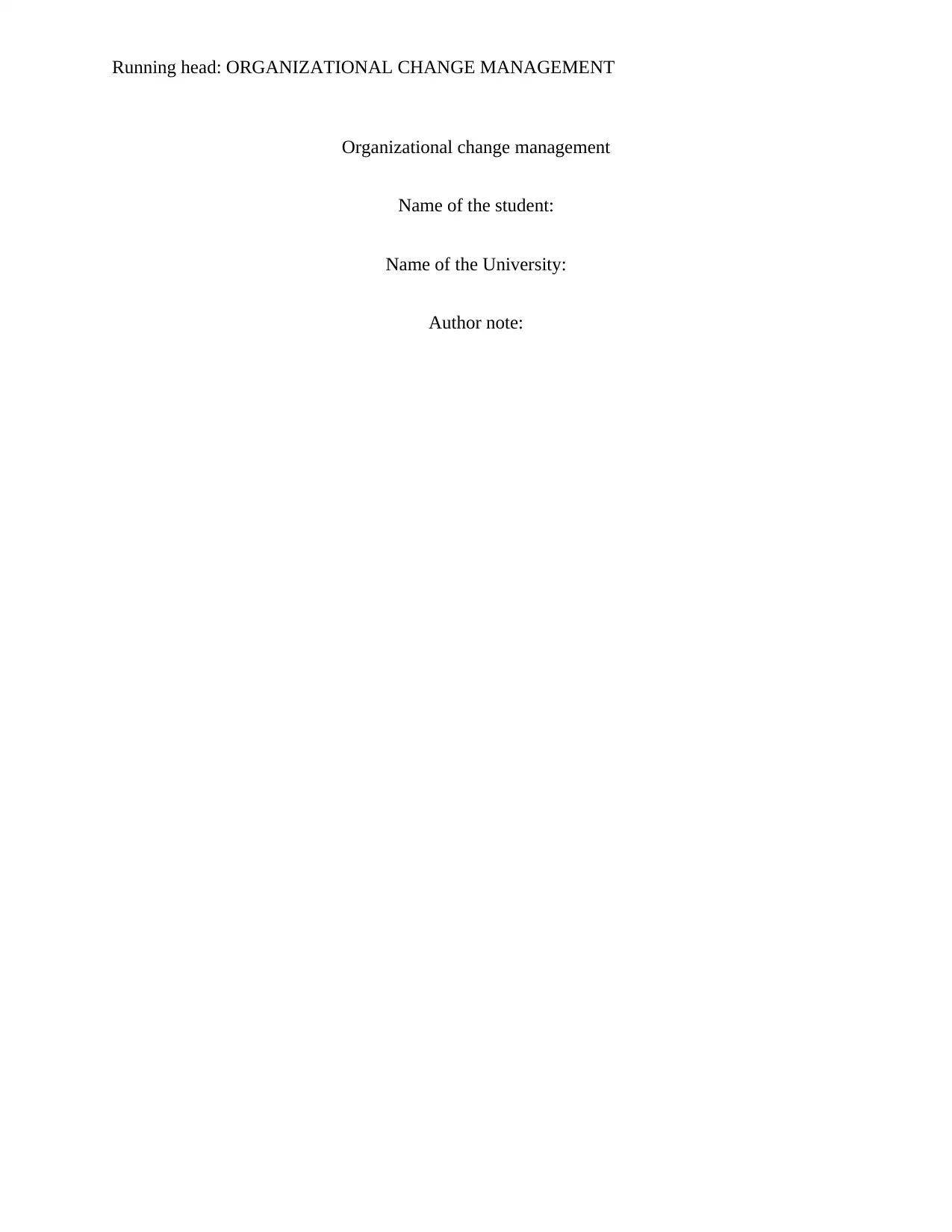
Running head: ORGANIZATIONAL CHANGE MANAGEMENT
Organizational change management
Name of the student:
Name of the University:
Author note:
Organizational change management
Name of the student:
Name of the University:
Author note:
Paraphrase This Document
Need a fresh take? Get an instant paraphrase of this document with our AI Paraphraser
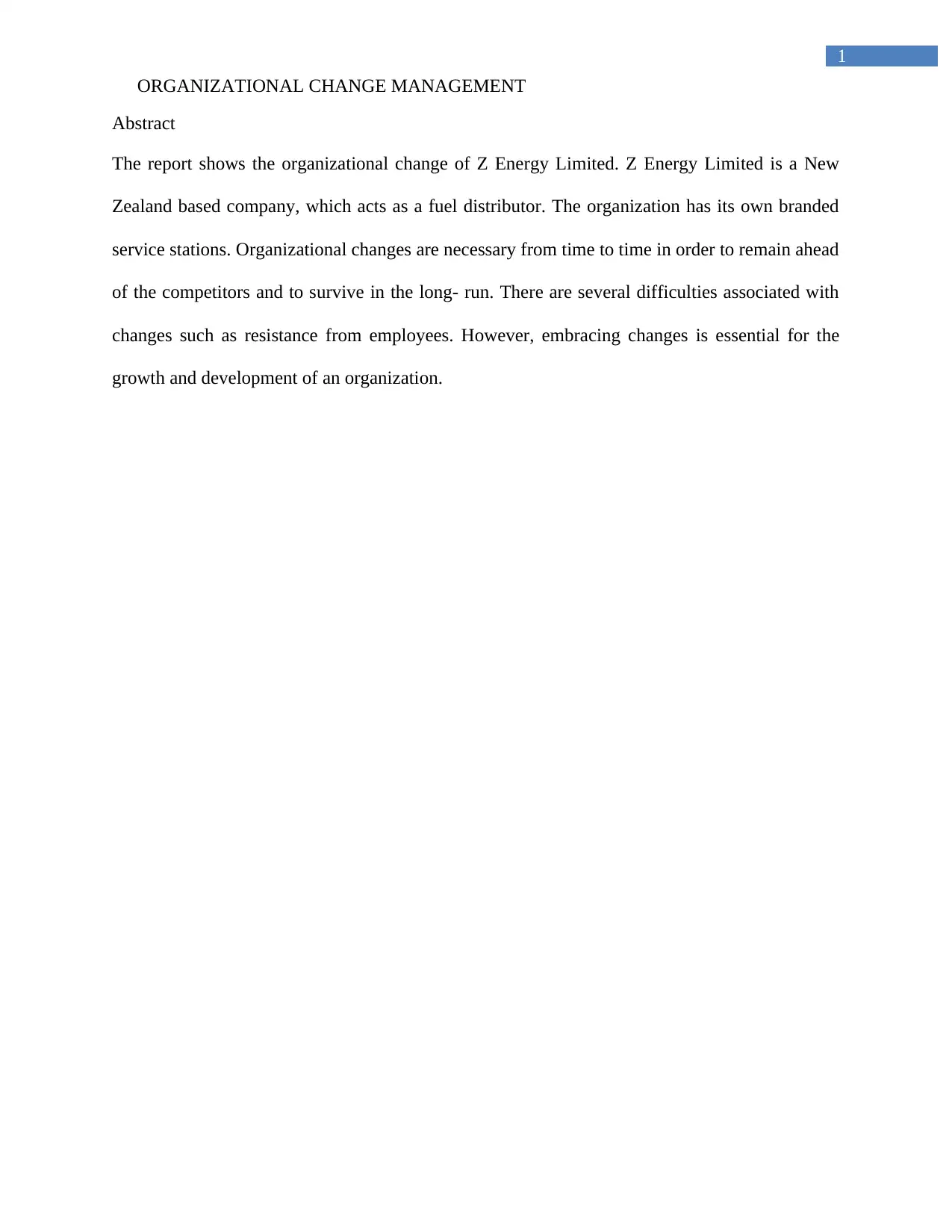
1
ORGANIZATIONAL CHANGE MANAGEMENT
Abstract
The report shows the organizational change of Z Energy Limited. Z Energy Limited is a New
Zealand based company, which acts as a fuel distributor. The organization has its own branded
service stations. Organizational changes are necessary from time to time in order to remain ahead
of the competitors and to survive in the long- run. There are several difficulties associated with
changes such as resistance from employees. However, embracing changes is essential for the
growth and development of an organization.
ORGANIZATIONAL CHANGE MANAGEMENT
Abstract
The report shows the organizational change of Z Energy Limited. Z Energy Limited is a New
Zealand based company, which acts as a fuel distributor. The organization has its own branded
service stations. Organizational changes are necessary from time to time in order to remain ahead
of the competitors and to survive in the long- run. There are several difficulties associated with
changes such as resistance from employees. However, embracing changes is essential for the
growth and development of an organization.
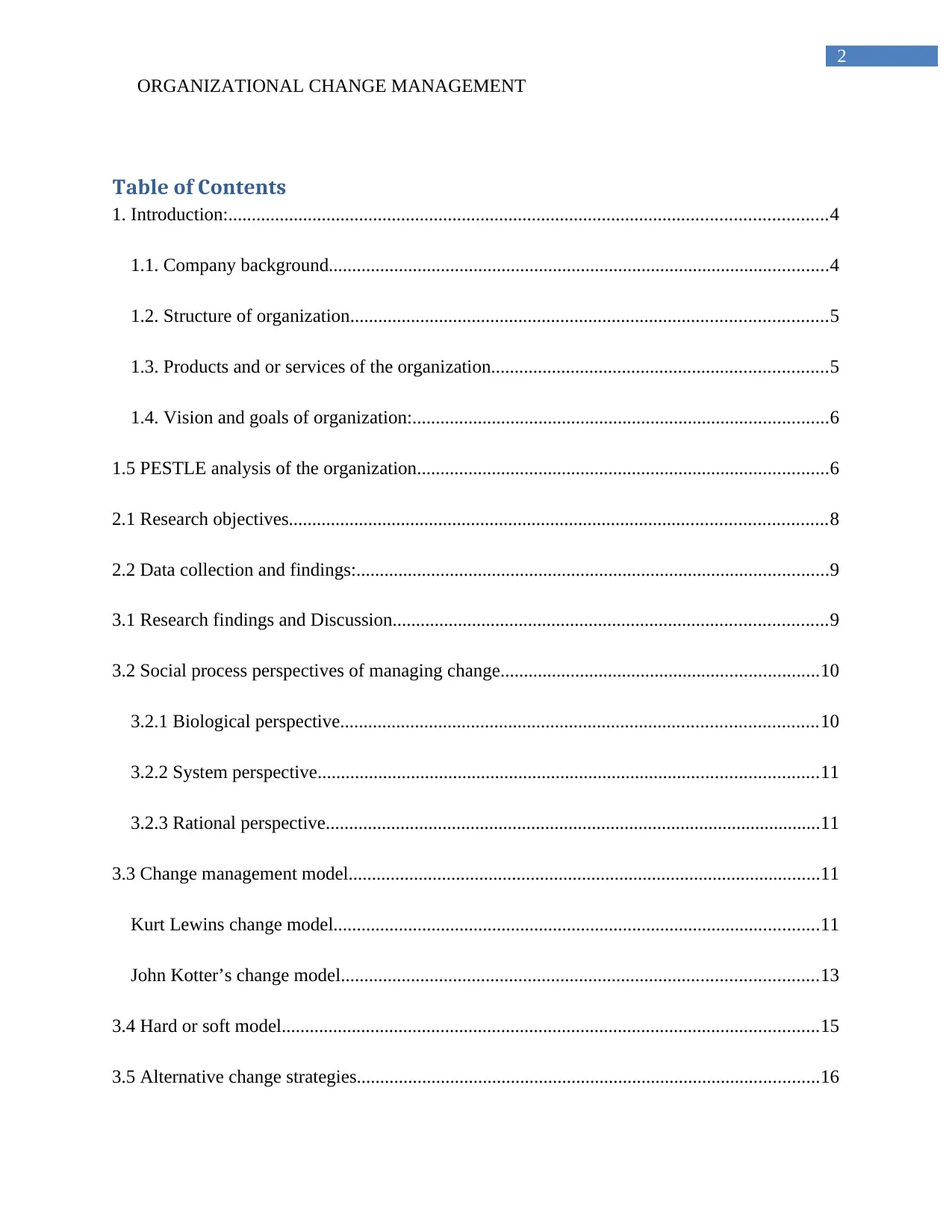
2
ORGANIZATIONAL CHANGE MANAGEMENT
Table of Contents
1. Introduction:................................................................................................................................4
1.1. Company background...........................................................................................................4
1.2. Structure of organization......................................................................................................5
1.3. Products and or services of the organization........................................................................5
1.4. Vision and goals of organization:.........................................................................................6
1.5 PESTLE analysis of the organization........................................................................................6
2.1 Research objectives...................................................................................................................8
2.2 Data collection and findings:.....................................................................................................9
3.1 Research findings and Discussion.............................................................................................9
3.2 Social process perspectives of managing change....................................................................10
3.2.1 Biological perspective......................................................................................................10
3.2.2 System perspective...........................................................................................................11
3.2.3 Rational perspective..........................................................................................................11
3.3 Change management model.....................................................................................................11
Kurt Lewins change model........................................................................................................11
John Kotter’s change model......................................................................................................13
3.4 Hard or soft model...................................................................................................................15
3.5 Alternative change strategies...................................................................................................16
ORGANIZATIONAL CHANGE MANAGEMENT
Table of Contents
1. Introduction:................................................................................................................................4
1.1. Company background...........................................................................................................4
1.2. Structure of organization......................................................................................................5
1.3. Products and or services of the organization........................................................................5
1.4. Vision and goals of organization:.........................................................................................6
1.5 PESTLE analysis of the organization........................................................................................6
2.1 Research objectives...................................................................................................................8
2.2 Data collection and findings:.....................................................................................................9
3.1 Research findings and Discussion.............................................................................................9
3.2 Social process perspectives of managing change....................................................................10
3.2.1 Biological perspective......................................................................................................10
3.2.2 System perspective...........................................................................................................11
3.2.3 Rational perspective..........................................................................................................11
3.3 Change management model.....................................................................................................11
Kurt Lewins change model........................................................................................................11
John Kotter’s change model......................................................................................................13
3.4 Hard or soft model...................................................................................................................15
3.5 Alternative change strategies...................................................................................................16
⊘ This is a preview!⊘
Do you want full access?
Subscribe today to unlock all pages.

Trusted by 1+ million students worldwide
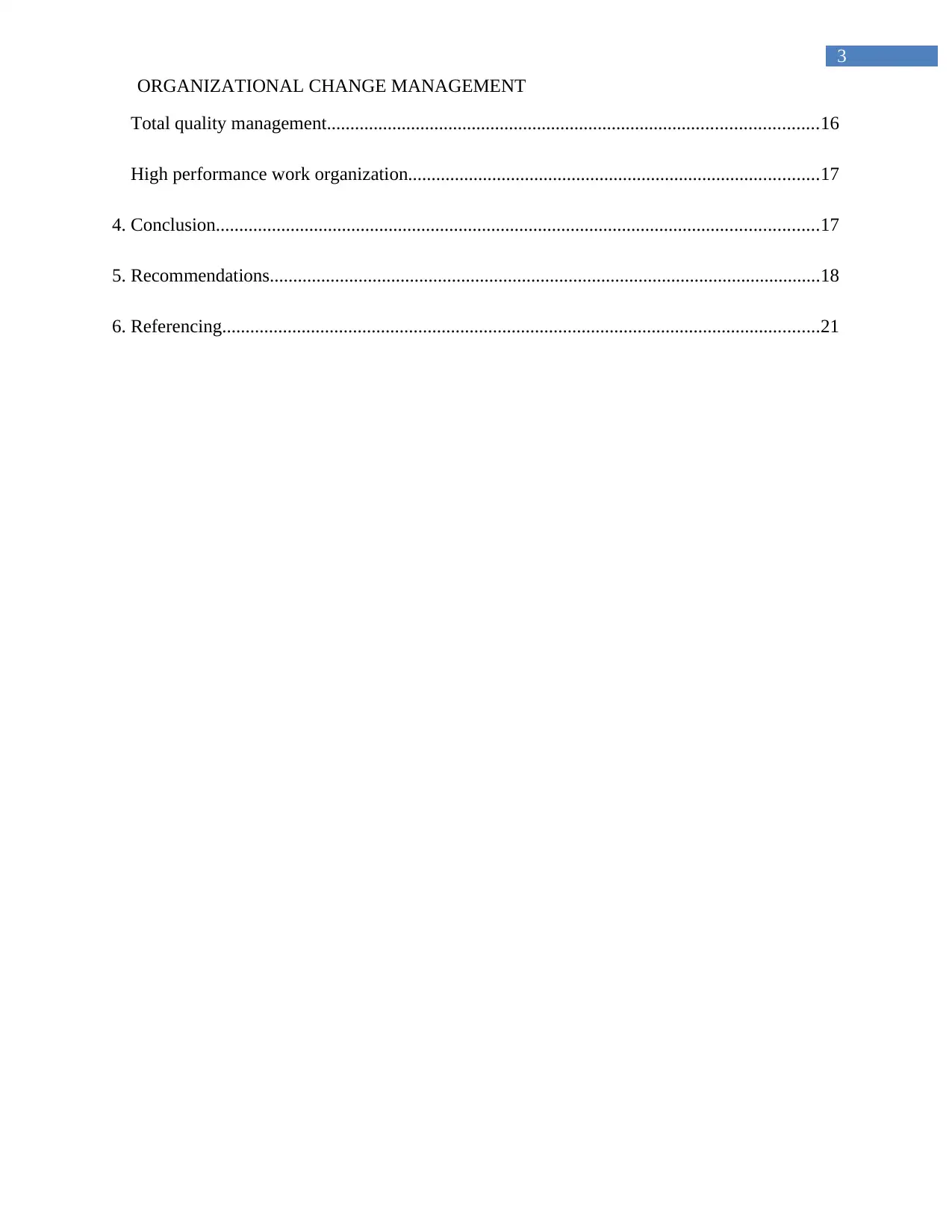
3
ORGANIZATIONAL CHANGE MANAGEMENT
Total quality management.........................................................................................................16
High performance work organization........................................................................................17
4. Conclusion.................................................................................................................................17
5. Recommendations......................................................................................................................18
6. Referencing................................................................................................................................21
ORGANIZATIONAL CHANGE MANAGEMENT
Total quality management.........................................................................................................16
High performance work organization........................................................................................17
4. Conclusion.................................................................................................................................17
5. Recommendations......................................................................................................................18
6. Referencing................................................................................................................................21
Paraphrase This Document
Need a fresh take? Get an instant paraphrase of this document with our AI Paraphraser
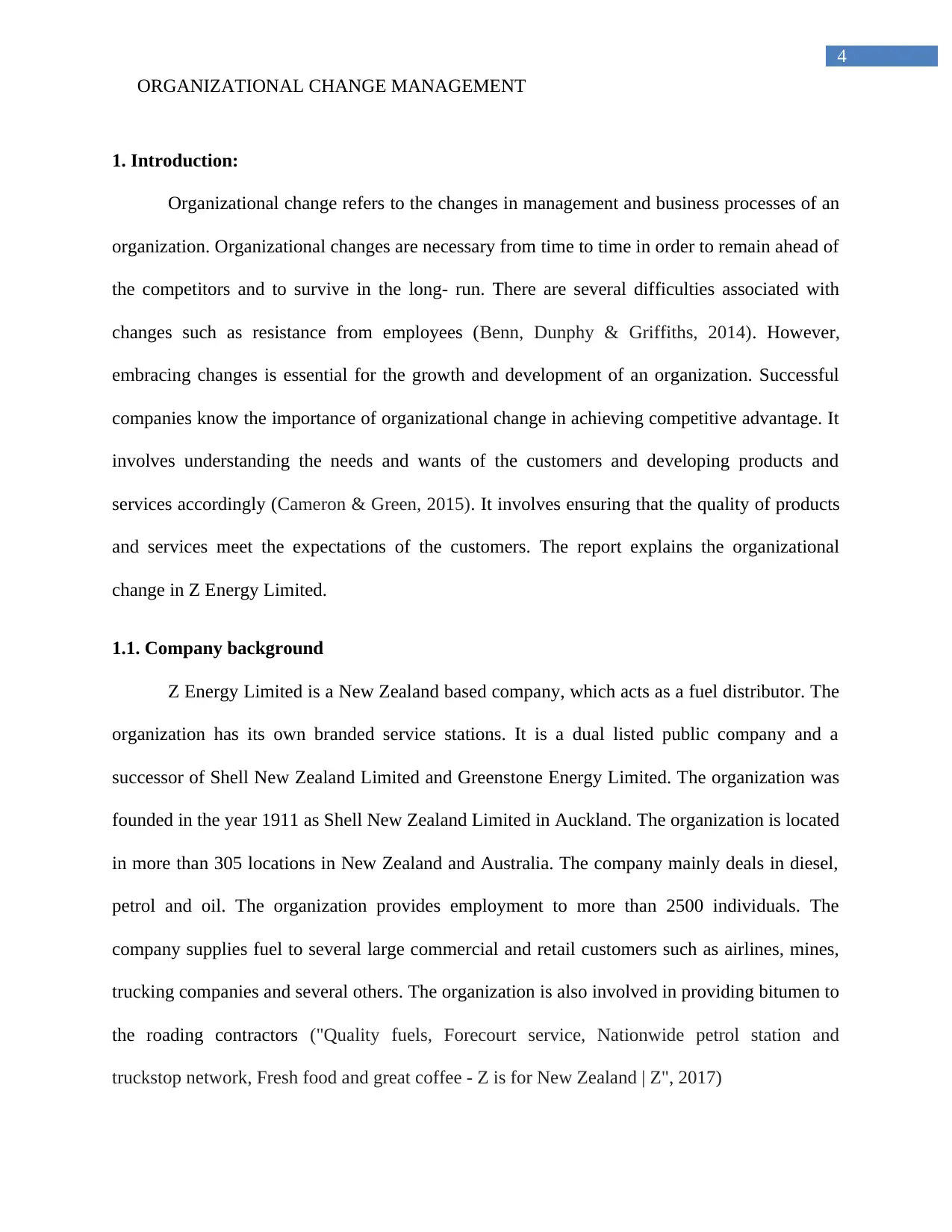
4
ORGANIZATIONAL CHANGE MANAGEMENT
1. Introduction:
Organizational change refers to the changes in management and business processes of an
organization. Organizational changes are necessary from time to time in order to remain ahead of
the competitors and to survive in the long- run. There are several difficulties associated with
changes such as resistance from employees (Benn, Dunphy & Griffiths, 2014). However,
embracing changes is essential for the growth and development of an organization. Successful
companies know the importance of organizational change in achieving competitive advantage. It
involves understanding the needs and wants of the customers and developing products and
services accordingly (Cameron & Green, 2015). It involves ensuring that the quality of products
and services meet the expectations of the customers. The report explains the organizational
change in Z Energy Limited.
1.1. Company background
Z Energy Limited is a New Zealand based company, which acts as a fuel distributor. The
organization has its own branded service stations. It is a dual listed public company and a
successor of Shell New Zealand Limited and Greenstone Energy Limited. The organization was
founded in the year 1911 as Shell New Zealand Limited in Auckland. The organization is located
in more than 305 locations in New Zealand and Australia. The company mainly deals in diesel,
petrol and oil. The organization provides employment to more than 2500 individuals. The
company supplies fuel to several large commercial and retail customers such as airlines, mines,
trucking companies and several others. The organization is also involved in providing bitumen to
the roading contractors ("Quality fuels, Forecourt service, Nationwide petrol station and
truckstop network, Fresh food and great coffee - Z is for New Zealand | Z", 2017)
ORGANIZATIONAL CHANGE MANAGEMENT
1. Introduction:
Organizational change refers to the changes in management and business processes of an
organization. Organizational changes are necessary from time to time in order to remain ahead of
the competitors and to survive in the long- run. There are several difficulties associated with
changes such as resistance from employees (Benn, Dunphy & Griffiths, 2014). However,
embracing changes is essential for the growth and development of an organization. Successful
companies know the importance of organizational change in achieving competitive advantage. It
involves understanding the needs and wants of the customers and developing products and
services accordingly (Cameron & Green, 2015). It involves ensuring that the quality of products
and services meet the expectations of the customers. The report explains the organizational
change in Z Energy Limited.
1.1. Company background
Z Energy Limited is a New Zealand based company, which acts as a fuel distributor. The
organization has its own branded service stations. It is a dual listed public company and a
successor of Shell New Zealand Limited and Greenstone Energy Limited. The organization was
founded in the year 1911 as Shell New Zealand Limited in Auckland. The organization is located
in more than 305 locations in New Zealand and Australia. The company mainly deals in diesel,
petrol and oil. The organization provides employment to more than 2500 individuals. The
company supplies fuel to several large commercial and retail customers such as airlines, mines,
trucking companies and several others. The organization is also involved in providing bitumen to
the roading contractors ("Quality fuels, Forecourt service, Nationwide petrol station and
truckstop network, Fresh food and great coffee - Z is for New Zealand | Z", 2017)
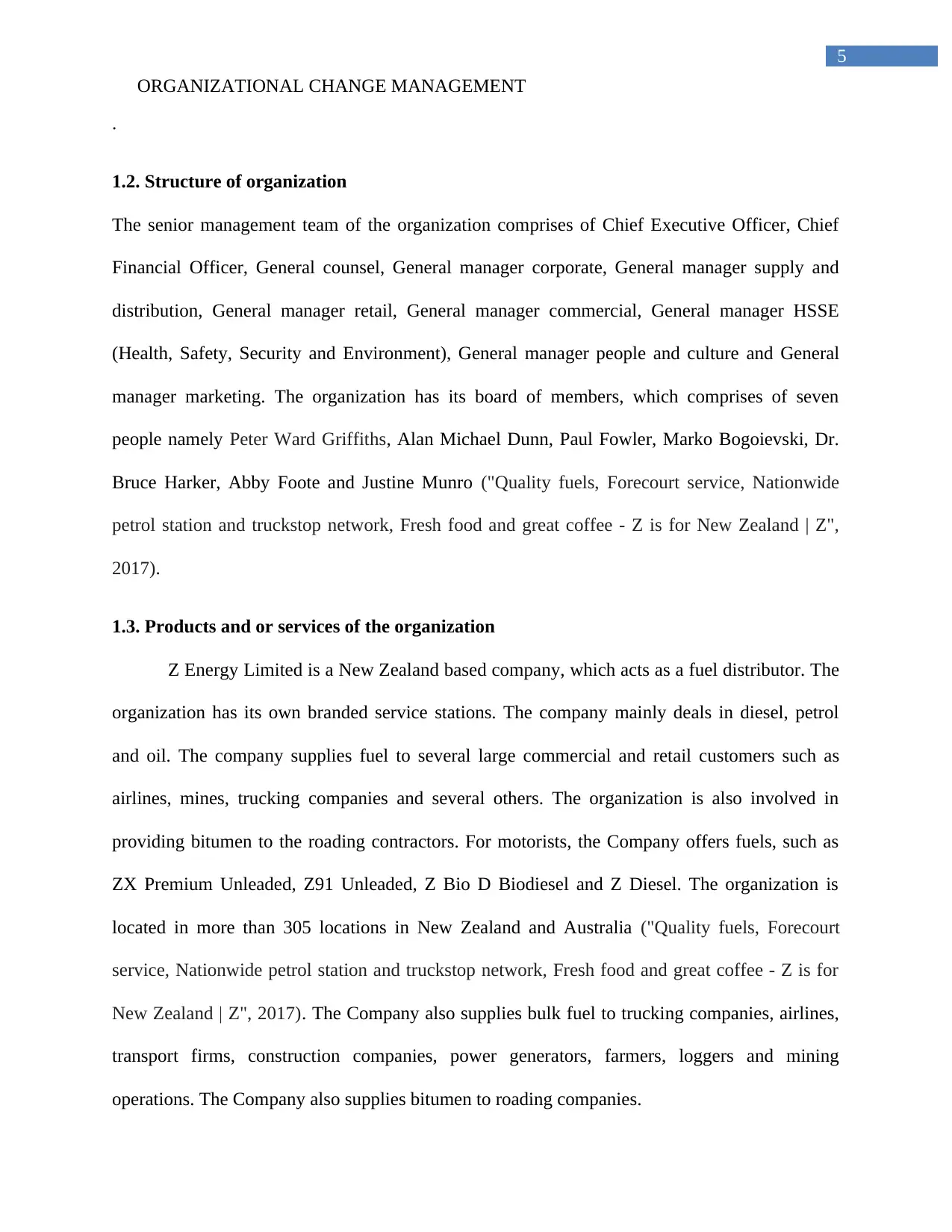
5
ORGANIZATIONAL CHANGE MANAGEMENT
.
1.2. Structure of organization
The senior management team of the organization comprises of Chief Executive Officer, Chief
Financial Officer, General counsel, General manager corporate, General manager supply and
distribution, General manager retail, General manager commercial, General manager HSSE
(Health, Safety, Security and Environment), General manager people and culture and General
manager marketing. The organization has its board of members, which comprises of seven
people namely Peter Ward Griffiths, Alan Michael Dunn, Paul Fowler, Marko Bogoievski, Dr.
Bruce Harker, Abby Foote and Justine Munro ("Quality fuels, Forecourt service, Nationwide
petrol station and truckstop network, Fresh food and great coffee - Z is for New Zealand | Z",
2017).
1.3. Products and or services of the organization
Z Energy Limited is a New Zealand based company, which acts as a fuel distributor. The
organization has its own branded service stations. The company mainly deals in diesel, petrol
and oil. The company supplies fuel to several large commercial and retail customers such as
airlines, mines, trucking companies and several others. The organization is also involved in
providing bitumen to the roading contractors. For motorists, the Company offers fuels, such as
ZX Premium Unleaded, Z91 Unleaded, Z Bio D Biodiesel and Z Diesel. The organization is
located in more than 305 locations in New Zealand and Australia ("Quality fuels, Forecourt
service, Nationwide petrol station and truckstop network, Fresh food and great coffee - Z is for
New Zealand | Z", 2017). The Company also supplies bulk fuel to trucking companies, airlines,
transport firms, construction companies, power generators, farmers, loggers and mining
operations. The Company also supplies bitumen to roading companies.
ORGANIZATIONAL CHANGE MANAGEMENT
.
1.2. Structure of organization
The senior management team of the organization comprises of Chief Executive Officer, Chief
Financial Officer, General counsel, General manager corporate, General manager supply and
distribution, General manager retail, General manager commercial, General manager HSSE
(Health, Safety, Security and Environment), General manager people and culture and General
manager marketing. The organization has its board of members, which comprises of seven
people namely Peter Ward Griffiths, Alan Michael Dunn, Paul Fowler, Marko Bogoievski, Dr.
Bruce Harker, Abby Foote and Justine Munro ("Quality fuels, Forecourt service, Nationwide
petrol station and truckstop network, Fresh food and great coffee - Z is for New Zealand | Z",
2017).
1.3. Products and or services of the organization
Z Energy Limited is a New Zealand based company, which acts as a fuel distributor. The
organization has its own branded service stations. The company mainly deals in diesel, petrol
and oil. The company supplies fuel to several large commercial and retail customers such as
airlines, mines, trucking companies and several others. The organization is also involved in
providing bitumen to the roading contractors. For motorists, the Company offers fuels, such as
ZX Premium Unleaded, Z91 Unleaded, Z Bio D Biodiesel and Z Diesel. The organization is
located in more than 305 locations in New Zealand and Australia ("Quality fuels, Forecourt
service, Nationwide petrol station and truckstop network, Fresh food and great coffee - Z is for
New Zealand | Z", 2017). The Company also supplies bulk fuel to trucking companies, airlines,
transport firms, construction companies, power generators, farmers, loggers and mining
operations. The Company also supplies bitumen to roading companies.
⊘ This is a preview!⊘
Do you want full access?
Subscribe today to unlock all pages.

Trusted by 1+ million students worldwide
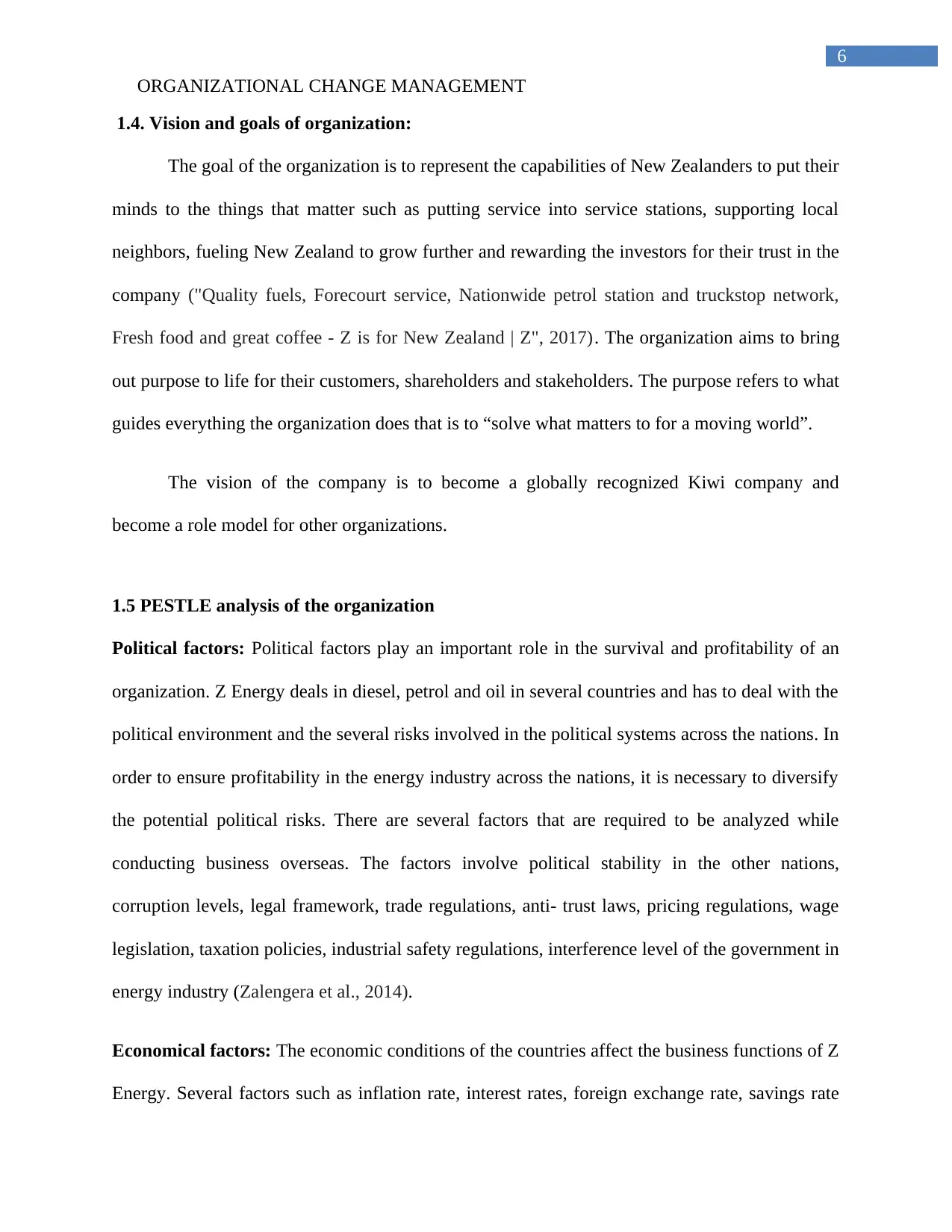
6
ORGANIZATIONAL CHANGE MANAGEMENT
1.4. Vision and goals of organization:
The goal of the organization is to represent the capabilities of New Zealanders to put their
minds to the things that matter such as putting service into service stations, supporting local
neighbors, fueling New Zealand to grow further and rewarding the investors for their trust in the
company ("Quality fuels, Forecourt service, Nationwide petrol station and truckstop network,
Fresh food and great coffee - Z is for New Zealand | Z", 2017). The organization aims to bring
out purpose to life for their customers, shareholders and stakeholders. The purpose refers to what
guides everything the organization does that is to “solve what matters to for a moving world”.
The vision of the company is to become a globally recognized Kiwi company and
become a role model for other organizations.
1.5 PESTLE analysis of the organization
Political factors: Political factors play an important role in the survival and profitability of an
organization. Z Energy deals in diesel, petrol and oil in several countries and has to deal with the
political environment and the several risks involved in the political systems across the nations. In
order to ensure profitability in the energy industry across the nations, it is necessary to diversify
the potential political risks. There are several factors that are required to be analyzed while
conducting business overseas. The factors involve political stability in the other nations,
corruption levels, legal framework, trade regulations, anti- trust laws, pricing regulations, wage
legislation, taxation policies, industrial safety regulations, interference level of the government in
energy industry (Zalengera et al., 2014).
Economical factors: The economic conditions of the countries affect the business functions of Z
Energy. Several factors such as inflation rate, interest rates, foreign exchange rate, savings rate
ORGANIZATIONAL CHANGE MANAGEMENT
1.4. Vision and goals of organization:
The goal of the organization is to represent the capabilities of New Zealanders to put their
minds to the things that matter such as putting service into service stations, supporting local
neighbors, fueling New Zealand to grow further and rewarding the investors for their trust in the
company ("Quality fuels, Forecourt service, Nationwide petrol station and truckstop network,
Fresh food and great coffee - Z is for New Zealand | Z", 2017). The organization aims to bring
out purpose to life for their customers, shareholders and stakeholders. The purpose refers to what
guides everything the organization does that is to “solve what matters to for a moving world”.
The vision of the company is to become a globally recognized Kiwi company and
become a role model for other organizations.
1.5 PESTLE analysis of the organization
Political factors: Political factors play an important role in the survival and profitability of an
organization. Z Energy deals in diesel, petrol and oil in several countries and has to deal with the
political environment and the several risks involved in the political systems across the nations. In
order to ensure profitability in the energy industry across the nations, it is necessary to diversify
the potential political risks. There are several factors that are required to be analyzed while
conducting business overseas. The factors involve political stability in the other nations,
corruption levels, legal framework, trade regulations, anti- trust laws, pricing regulations, wage
legislation, taxation policies, industrial safety regulations, interference level of the government in
energy industry (Zalengera et al., 2014).
Economical factors: The economic conditions of the countries affect the business functions of Z
Energy. Several factors such as inflation rate, interest rates, foreign exchange rate, savings rate
Paraphrase This Document
Need a fresh take? Get an instant paraphrase of this document with our AI Paraphraser
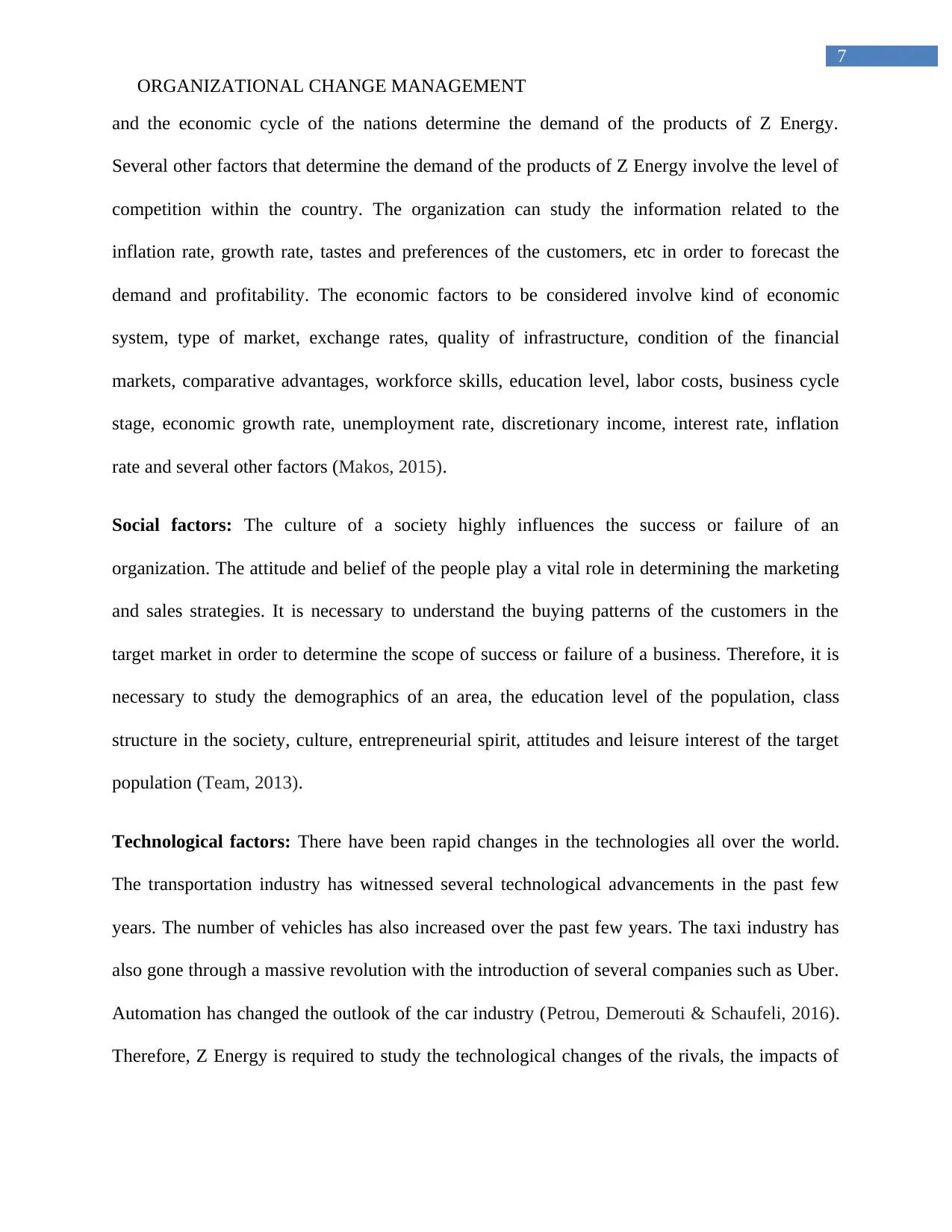
7
ORGANIZATIONAL CHANGE MANAGEMENT
and the economic cycle of the nations determine the demand of the products of Z Energy.
Several other factors that determine the demand of the products of Z Energy involve the level of
competition within the country. The organization can study the information related to the
inflation rate, growth rate, tastes and preferences of the customers, etc in order to forecast the
demand and profitability. The economic factors to be considered involve kind of economic
system, type of market, exchange rates, quality of infrastructure, condition of the financial
markets, comparative advantages, workforce skills, education level, labor costs, business cycle
stage, economic growth rate, unemployment rate, discretionary income, interest rate, inflation
rate and several other factors (Makos, 2015).
Social factors: The culture of a society highly influences the success or failure of an
organization. The attitude and belief of the people play a vital role in determining the marketing
and sales strategies. It is necessary to understand the buying patterns of the customers in the
target market in order to determine the scope of success or failure of a business. Therefore, it is
necessary to study the demographics of an area, the education level of the population, class
structure in the society, culture, entrepreneurial spirit, attitudes and leisure interest of the target
population (Team, 2013).
Technological factors: There have been rapid changes in the technologies all over the world.
The transportation industry has witnessed several technological advancements in the past few
years. The number of vehicles has also increased over the past few years. The taxi industry has
also gone through a massive revolution with the introduction of several companies such as Uber.
Automation has changed the outlook of the car industry (Petrou, Demerouti & Schaufeli, 2016).
Therefore, Z Energy is required to study the technological changes of the rivals, the impacts of
ORGANIZATIONAL CHANGE MANAGEMENT
and the economic cycle of the nations determine the demand of the products of Z Energy.
Several other factors that determine the demand of the products of Z Energy involve the level of
competition within the country. The organization can study the information related to the
inflation rate, growth rate, tastes and preferences of the customers, etc in order to forecast the
demand and profitability. The economic factors to be considered involve kind of economic
system, type of market, exchange rates, quality of infrastructure, condition of the financial
markets, comparative advantages, workforce skills, education level, labor costs, business cycle
stage, economic growth rate, unemployment rate, discretionary income, interest rate, inflation
rate and several other factors (Makos, 2015).
Social factors: The culture of a society highly influences the success or failure of an
organization. The attitude and belief of the people play a vital role in determining the marketing
and sales strategies. It is necessary to understand the buying patterns of the customers in the
target market in order to determine the scope of success or failure of a business. Therefore, it is
necessary to study the demographics of an area, the education level of the population, class
structure in the society, culture, entrepreneurial spirit, attitudes and leisure interest of the target
population (Team, 2013).
Technological factors: There have been rapid changes in the technologies all over the world.
The transportation industry has witnessed several technological advancements in the past few
years. The number of vehicles has also increased over the past few years. The taxi industry has
also gone through a massive revolution with the introduction of several companies such as Uber.
Automation has changed the outlook of the car industry (Petrou, Demerouti & Schaufeli, 2016).
Therefore, Z Energy is required to study the technological changes of the rivals, the impacts of
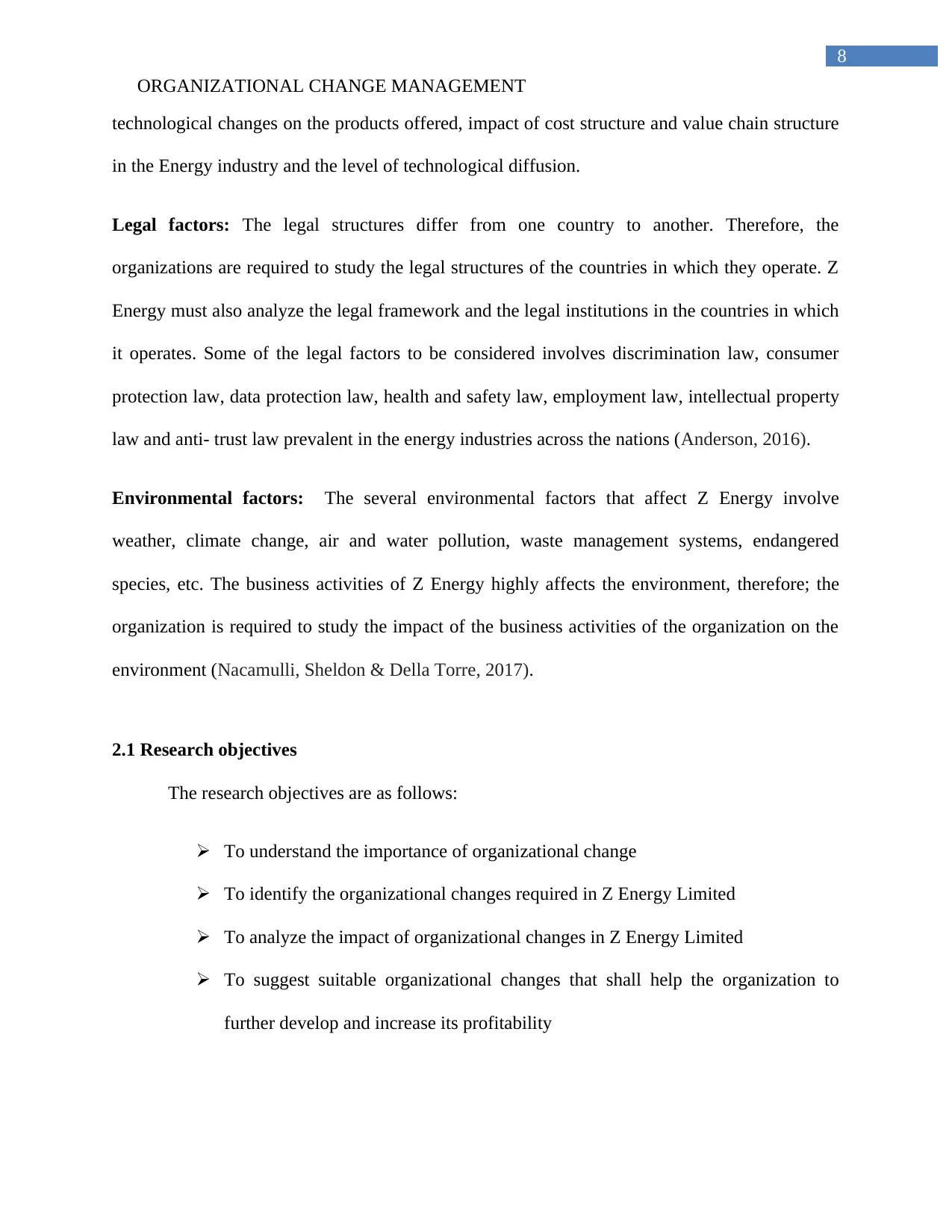
8
ORGANIZATIONAL CHANGE MANAGEMENT
technological changes on the products offered, impact of cost structure and value chain structure
in the Energy industry and the level of technological diffusion.
Legal factors: The legal structures differ from one country to another. Therefore, the
organizations are required to study the legal structures of the countries in which they operate. Z
Energy must also analyze the legal framework and the legal institutions in the countries in which
it operates. Some of the legal factors to be considered involves discrimination law, consumer
protection law, data protection law, health and safety law, employment law, intellectual property
law and anti- trust law prevalent in the energy industries across the nations (Anderson, 2016).
Environmental factors: The several environmental factors that affect Z Energy involve
weather, climate change, air and water pollution, waste management systems, endangered
species, etc. The business activities of Z Energy highly affects the environment, therefore; the
organization is required to study the impact of the business activities of the organization on the
environment (Nacamulli, Sheldon & Della Torre, 2017).
2.1 Research objectives
The research objectives are as follows:
To understand the importance of organizational change
To identify the organizational changes required in Z Energy Limited
To analyze the impact of organizational changes in Z Energy Limited
To suggest suitable organizational changes that shall help the organization to
further develop and increase its profitability
ORGANIZATIONAL CHANGE MANAGEMENT
technological changes on the products offered, impact of cost structure and value chain structure
in the Energy industry and the level of technological diffusion.
Legal factors: The legal structures differ from one country to another. Therefore, the
organizations are required to study the legal structures of the countries in which they operate. Z
Energy must also analyze the legal framework and the legal institutions in the countries in which
it operates. Some of the legal factors to be considered involves discrimination law, consumer
protection law, data protection law, health and safety law, employment law, intellectual property
law and anti- trust law prevalent in the energy industries across the nations (Anderson, 2016).
Environmental factors: The several environmental factors that affect Z Energy involve
weather, climate change, air and water pollution, waste management systems, endangered
species, etc. The business activities of Z Energy highly affects the environment, therefore; the
organization is required to study the impact of the business activities of the organization on the
environment (Nacamulli, Sheldon & Della Torre, 2017).
2.1 Research objectives
The research objectives are as follows:
To understand the importance of organizational change
To identify the organizational changes required in Z Energy Limited
To analyze the impact of organizational changes in Z Energy Limited
To suggest suitable organizational changes that shall help the organization to
further develop and increase its profitability
⊘ This is a preview!⊘
Do you want full access?
Subscribe today to unlock all pages.

Trusted by 1+ million students worldwide
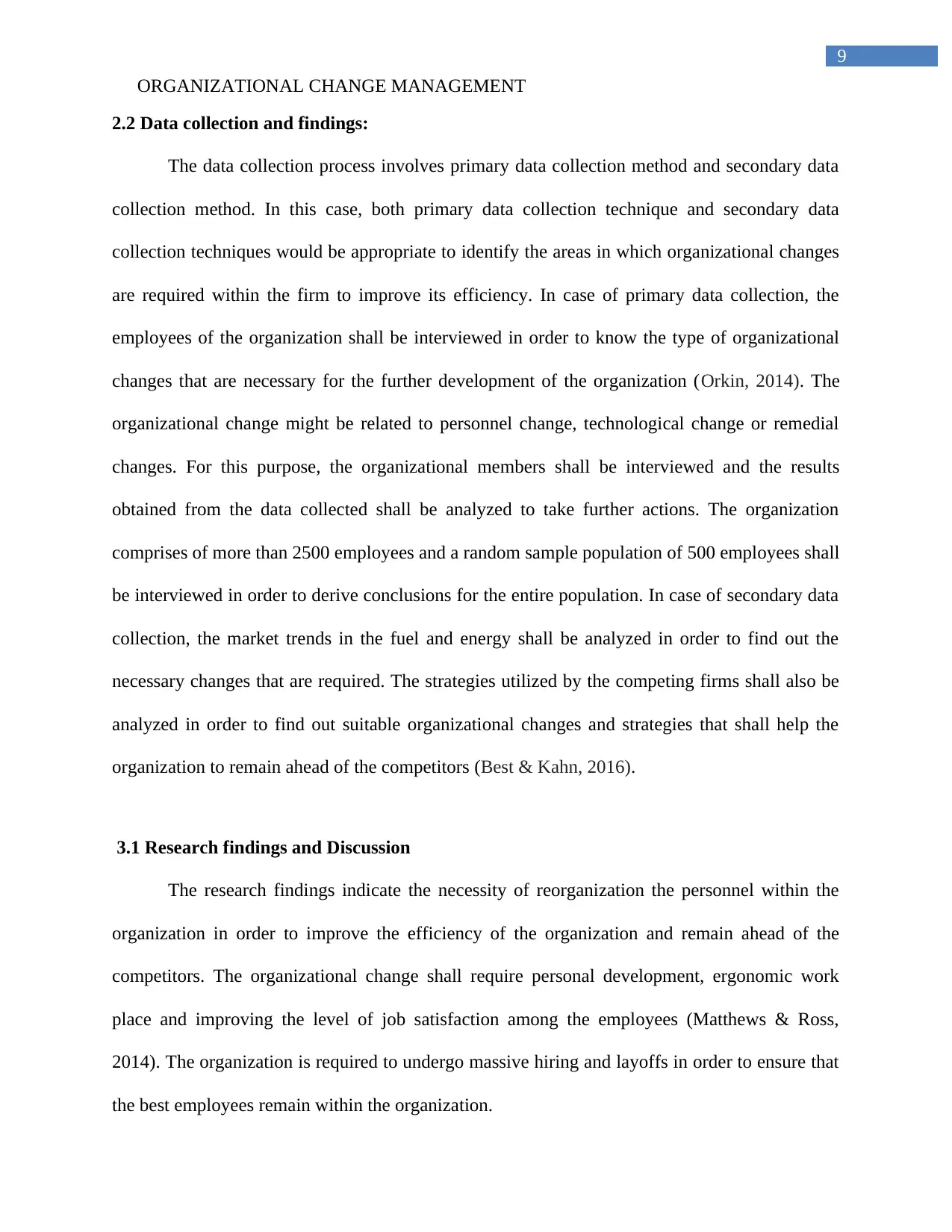
9
ORGANIZATIONAL CHANGE MANAGEMENT
2.2 Data collection and findings:
The data collection process involves primary data collection method and secondary data
collection method. In this case, both primary data collection technique and secondary data
collection techniques would be appropriate to identify the areas in which organizational changes
are required within the firm to improve its efficiency. In case of primary data collection, the
employees of the organization shall be interviewed in order to know the type of organizational
changes that are necessary for the further development of the organization (Orkin, 2014). The
organizational change might be related to personnel change, technological change or remedial
changes. For this purpose, the organizational members shall be interviewed and the results
obtained from the data collected shall be analyzed to take further actions. The organization
comprises of more than 2500 employees and a random sample population of 500 employees shall
be interviewed in order to derive conclusions for the entire population. In case of secondary data
collection, the market trends in the fuel and energy shall be analyzed in order to find out the
necessary changes that are required. The strategies utilized by the competing firms shall also be
analyzed in order to find out suitable organizational changes and strategies that shall help the
organization to remain ahead of the competitors (Best & Kahn, 2016).
3.1 Research findings and Discussion
The research findings indicate the necessity of reorganization the personnel within the
organization in order to improve the efficiency of the organization and remain ahead of the
competitors. The organizational change shall require personal development, ergonomic work
place and improving the level of job satisfaction among the employees (Matthews & Ross,
2014). The organization is required to undergo massive hiring and layoffs in order to ensure that
the best employees remain within the organization.
ORGANIZATIONAL CHANGE MANAGEMENT
2.2 Data collection and findings:
The data collection process involves primary data collection method and secondary data
collection method. In this case, both primary data collection technique and secondary data
collection techniques would be appropriate to identify the areas in which organizational changes
are required within the firm to improve its efficiency. In case of primary data collection, the
employees of the organization shall be interviewed in order to know the type of organizational
changes that are necessary for the further development of the organization (Orkin, 2014). The
organizational change might be related to personnel change, technological change or remedial
changes. For this purpose, the organizational members shall be interviewed and the results
obtained from the data collected shall be analyzed to take further actions. The organization
comprises of more than 2500 employees and a random sample population of 500 employees shall
be interviewed in order to derive conclusions for the entire population. In case of secondary data
collection, the market trends in the fuel and energy shall be analyzed in order to find out the
necessary changes that are required. The strategies utilized by the competing firms shall also be
analyzed in order to find out suitable organizational changes and strategies that shall help the
organization to remain ahead of the competitors (Best & Kahn, 2016).
3.1 Research findings and Discussion
The research findings indicate the necessity of reorganization the personnel within the
organization in order to improve the efficiency of the organization and remain ahead of the
competitors. The organizational change shall require personal development, ergonomic work
place and improving the level of job satisfaction among the employees (Matthews & Ross,
2014). The organization is required to undergo massive hiring and layoffs in order to ensure that
the best employees remain within the organization.
Paraphrase This Document
Need a fresh take? Get an instant paraphrase of this document with our AI Paraphraser
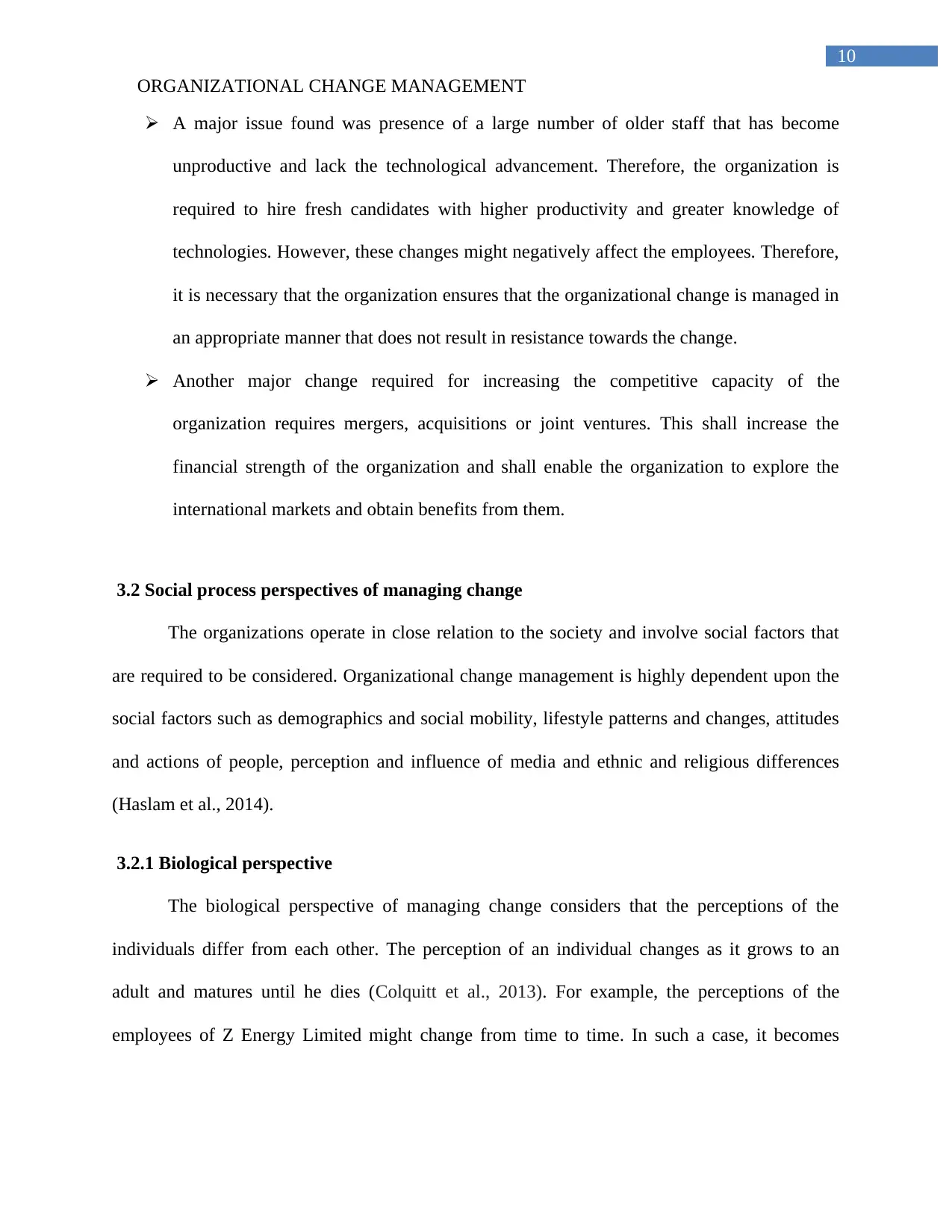
10
ORGANIZATIONAL CHANGE MANAGEMENT
A major issue found was presence of a large number of older staff that has become
unproductive and lack the technological advancement. Therefore, the organization is
required to hire fresh candidates with higher productivity and greater knowledge of
technologies. However, these changes might negatively affect the employees. Therefore,
it is necessary that the organization ensures that the organizational change is managed in
an appropriate manner that does not result in resistance towards the change.
Another major change required for increasing the competitive capacity of the
organization requires mergers, acquisitions or joint ventures. This shall increase the
financial strength of the organization and shall enable the organization to explore the
international markets and obtain benefits from them.
3.2 Social process perspectives of managing change
The organizations operate in close relation to the society and involve social factors that
are required to be considered. Organizational change management is highly dependent upon the
social factors such as demographics and social mobility, lifestyle patterns and changes, attitudes
and actions of people, perception and influence of media and ethnic and religious differences
(Haslam et al., 2014).
3.2.1 Biological perspective
The biological perspective of managing change considers that the perceptions of the
individuals differ from each other. The perception of an individual changes as it grows to an
adult and matures until he dies (Colquitt et al., 2013). For example, the perceptions of the
employees of Z Energy Limited might change from time to time. In such a case, it becomes
ORGANIZATIONAL CHANGE MANAGEMENT
A major issue found was presence of a large number of older staff that has become
unproductive and lack the technological advancement. Therefore, the organization is
required to hire fresh candidates with higher productivity and greater knowledge of
technologies. However, these changes might negatively affect the employees. Therefore,
it is necessary that the organization ensures that the organizational change is managed in
an appropriate manner that does not result in resistance towards the change.
Another major change required for increasing the competitive capacity of the
organization requires mergers, acquisitions or joint ventures. This shall increase the
financial strength of the organization and shall enable the organization to explore the
international markets and obtain benefits from them.
3.2 Social process perspectives of managing change
The organizations operate in close relation to the society and involve social factors that
are required to be considered. Organizational change management is highly dependent upon the
social factors such as demographics and social mobility, lifestyle patterns and changes, attitudes
and actions of people, perception and influence of media and ethnic and religious differences
(Haslam et al., 2014).
3.2.1 Biological perspective
The biological perspective of managing change considers that the perceptions of the
individuals differ from each other. The perception of an individual changes as it grows to an
adult and matures until he dies (Colquitt et al., 2013). For example, the perceptions of the
employees of Z Energy Limited might change from time to time. In such a case, it becomes
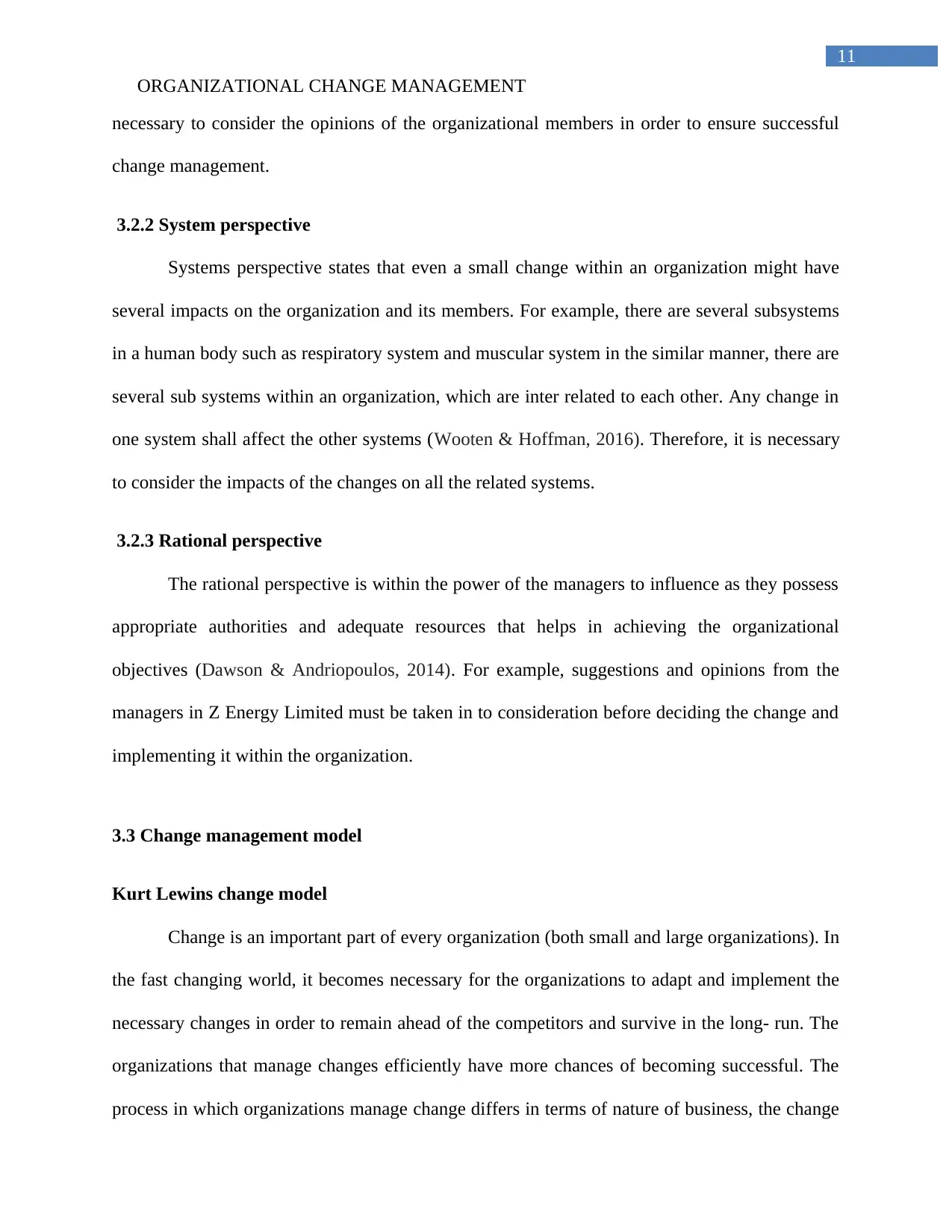
11
ORGANIZATIONAL CHANGE MANAGEMENT
necessary to consider the opinions of the organizational members in order to ensure successful
change management.
3.2.2 System perspective
Systems perspective states that even a small change within an organization might have
several impacts on the organization and its members. For example, there are several subsystems
in a human body such as respiratory system and muscular system in the similar manner, there are
several sub systems within an organization, which are inter related to each other. Any change in
one system shall affect the other systems (Wooten & Hoffman, 2016). Therefore, it is necessary
to consider the impacts of the changes on all the related systems.
3.2.3 Rational perspective
The rational perspective is within the power of the managers to influence as they possess
appropriate authorities and adequate resources that helps in achieving the organizational
objectives (Dawson & Andriopoulos, 2014). For example, suggestions and opinions from the
managers in Z Energy Limited must be taken in to consideration before deciding the change and
implementing it within the organization.
3.3 Change management model
Kurt Lewins change model
Change is an important part of every organization (both small and large organizations). In
the fast changing world, it becomes necessary for the organizations to adapt and implement the
necessary changes in order to remain ahead of the competitors and survive in the long- run. The
organizations that manage changes efficiently have more chances of becoming successful. The
process in which organizations manage change differs in terms of nature of business, the change
ORGANIZATIONAL CHANGE MANAGEMENT
necessary to consider the opinions of the organizational members in order to ensure successful
change management.
3.2.2 System perspective
Systems perspective states that even a small change within an organization might have
several impacts on the organization and its members. For example, there are several subsystems
in a human body such as respiratory system and muscular system in the similar manner, there are
several sub systems within an organization, which are inter related to each other. Any change in
one system shall affect the other systems (Wooten & Hoffman, 2016). Therefore, it is necessary
to consider the impacts of the changes on all the related systems.
3.2.3 Rational perspective
The rational perspective is within the power of the managers to influence as they possess
appropriate authorities and adequate resources that helps in achieving the organizational
objectives (Dawson & Andriopoulos, 2014). For example, suggestions and opinions from the
managers in Z Energy Limited must be taken in to consideration before deciding the change and
implementing it within the organization.
3.3 Change management model
Kurt Lewins change model
Change is an important part of every organization (both small and large organizations). In
the fast changing world, it becomes necessary for the organizations to adapt and implement the
necessary changes in order to remain ahead of the competitors and survive in the long- run. The
organizations that manage changes efficiently have more chances of becoming successful. The
process in which organizations manage change differs in terms of nature of business, the change
⊘ This is a preview!⊘
Do you want full access?
Subscribe today to unlock all pages.

Trusted by 1+ million students worldwide
1 out of 24
Related Documents
Your All-in-One AI-Powered Toolkit for Academic Success.
+13062052269
info@desklib.com
Available 24*7 on WhatsApp / Email
![[object Object]](/_next/static/media/star-bottom.7253800d.svg)
Unlock your academic potential
Copyright © 2020–2025 A2Z Services. All Rights Reserved. Developed and managed by ZUCOL.





